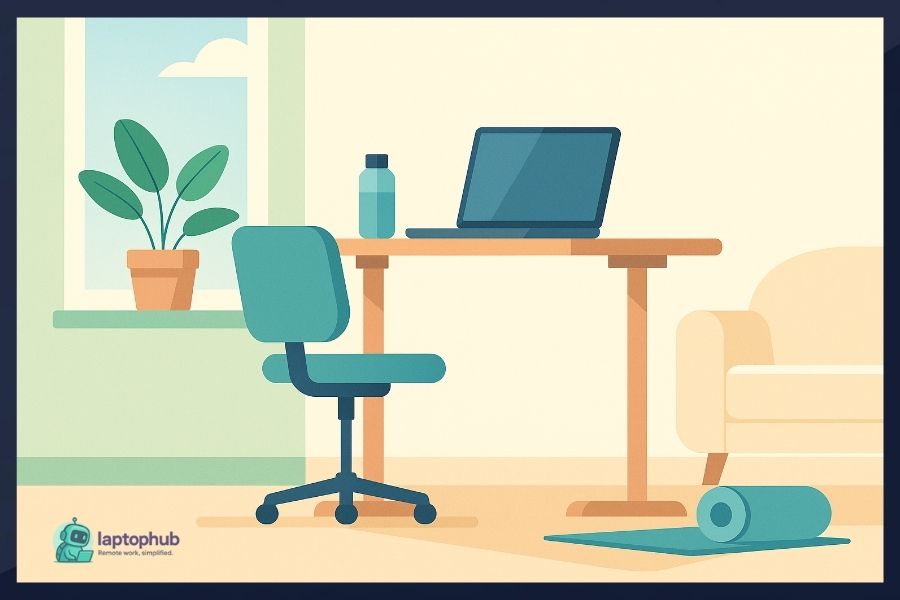When I first embraced remote work, I assumed the flexibility would naturally make me healthier — fewer commutes, home-cooked meals, and a calmer pace. Instead, I faced stiff muscles, endless snacking, and creeping isolation that blindsided me.
Stay healthy while working remotely isn’t a lucky accident; it’s a skill that demands daily, deliberate choices.
Here’s what I’ve learned — and what truly works — if you want to thrive, not just survive, from your home office.
💡Key takeaways:
- Building consistent movement, ergonomic setups, and healthy eating habits is essential to stay physically well while working remotely.
- Protecting mental health with social connections, boundary-setting, and mindful breaks prevents remote work burnout.
- Prioritizing quality sleep, hydration, and daily sunlight exposure boosts productivity, creativity, and long-term resilience.
- Regular self-check-ins help remote workers adjust habits early, supporting sustainable health and peak performance.
1. Build Real Movement Into Your Workday
One of the hidden traps of remote work is how little you end up moving.
Without an office environment, it’s easy to sit for six, seven, even eight hours straight — and your body feels it.
What’s helped me stay active:
- Micro-breaks every hour — even just standing up, stretching, or doing a few shoulder rolls.
- Walking meetings — whenever possible, I take phone calls while pacing around.
- Intentional movement triggers — like doing 10 jumping jacks before starting a new task.
Pro tip:
Set a recurring calendar reminder labeled “MOVE” — you’d be surprised how effective a little nudge can be.
Remember: You don’t need a fancy gym setup. Movement beats perfection every time.
2. Create an Ergonomic, Inviting Workspace
Grabbing your laptop and plopping on the couch feels comfortable — for about twenty minutes.
Long-term? It leads to neck strain, sore wrists, and creeping back pain.
Here’s what genuinely made a difference for me:
- A supportive chair with lumbar support.
- A laptop stand to keep the screen at eye level (plus an external keyboard and mouse).
- A dedicated workspace, even if it’s just a small corner, to mentally separate work mode from relaxation.
Bonus: Adding small touches like a plant, good lighting, or a cozy rug makes your workspace feel less like a cubicle and more like a personal haven.
An ergonomic setup isn’t a luxury when you’re remote — it’s basic survival.
3. Stick to Structured Eating Habits (and Watch Out for “Snack Drift”)
When the kitchen is ten steps away, it’s tempting to treat yourself all day long.
But irregular eating wreaks havoc on energy levels and can lead to sluggish afternoons.
What keeps my eating on track:
- Scheduled meals, not “whenever I feel like it” snacking.
- Pre-prepped healthy options like boiled eggs, pre-cut veggies, and trail mix.
- Mindful eating — stepping away from the laptop during meals instead of multitasking.
Tip: Make lunch an event, not a pit stop. Even 20 minutes away from screens can reset your brain.
4. Protect Your Mental Health Like Your Paycheck Depends on It
Remote work can be isolating if you’re not intentional about human interaction.
Without quick hallway chats or shared lunch breaks, loneliness can sneak up fast.
Here’s how I stay mentally strong:
- Daily check-ins with real people, not just Slack pings.
- Boundaries that stick — setting clear work start and end times.
- Non-digital hobbies — painting, gardening, or even puzzles to break the endless screen cycle.
Important:
Mental health maintenance isn’t “optional.” It’s the foundation that supports everything else — including your best work.
5. Make Sleep a Non-Negotiable Priority
Without a commute to anchor your mornings, it’s easy to let sleep patterns slide.
But irregular bedtimes mess with your focus, creativity, and resilience. Sleep isn’t a passive activity; it’s one of the most powerful performance tools you have.
Sleep habits that changed the game for me:
- Consistent sleep and wake times, even on weekends.
- Screen curfews — shutting off devices at least an hour before bed.
- Low-light evenings — dimming lights after sunset to cue my body it’s time to wind down.
Simple rule: Treat your sleep like your most important meeting — because your brain depends on it.
6. Get Daily Sunlight and Fresh Air (Yes, Even on Busy Days)
You can easily go from 9 to 5 without stepping outside. I’ve done it — and I always felt worse for it.
Natural light regulates your circadian rhythm, lifts your mood, and boosts Vitamin D levels.
Easy ways to get your dose:
- Morning coffee on the balcony or porch.
- Lunchtime walks — even if it’s just 10 minutes around the block.
- Working next to a window whenever possible.
Bonus tip:
If you live somewhere gloomy, invest in a light therapy lamp — it made a noticeable difference for me during darker seasons.
Nature is the most underused productivity hack for remote workers.
7. Stay Hydrated (More Than You Think)
This sounds basic, but it’s wildly underrated.
At home, without a water cooler or regular coffee runs, it’s easy to forget to drink enough.
Hydration habits that stick:
- Keeping a large water bottle at my desk.
- Starting the day with a glass of water before coffee.
- Setting mini-goals like “finish this bottle before noon.”
Pro tip: Add a pinch of sea salt to your water for better mineral absorption — a tiny tweak that fuels your energy more efficiently.
How can I stay physically active while working remotely?
Break up your day with short movement sessions, schedule walking meetings, and create simple exercise anchors like stretching after meetings.
How to stay healthy while working remotely FAQs
Without intentional connection and boundaries, remote work can lead to isolation, stress, and burnout that affect both your performance and personal happiness.
Invest in ergonomic furniture, use a laptop stand to maintain eye-level posture, and separate your work zone from your relaxation areas.
Set structured meal times, prep healthy snacks ahead of time, and step away from your desk during meals to practice mindful eating.
Sunlight regulates your body’s natural rhythms, boosts Vitamin D, improves mood, and increases overall energy — making it vital for daily health.
Final Thoughts: Small Habits, Big Impact
Staying healthy while working remotely isn’t about perfect diets, intense workouts, or rigid routines. It’s about layering small, sustainable habits that make your days feel better — physically, mentally, emotionally. Start where you are, tweak as you go, and remember: remote work should enhance your life, not deplete it.
Take care of yourself — you’re the most important part of your home office.





